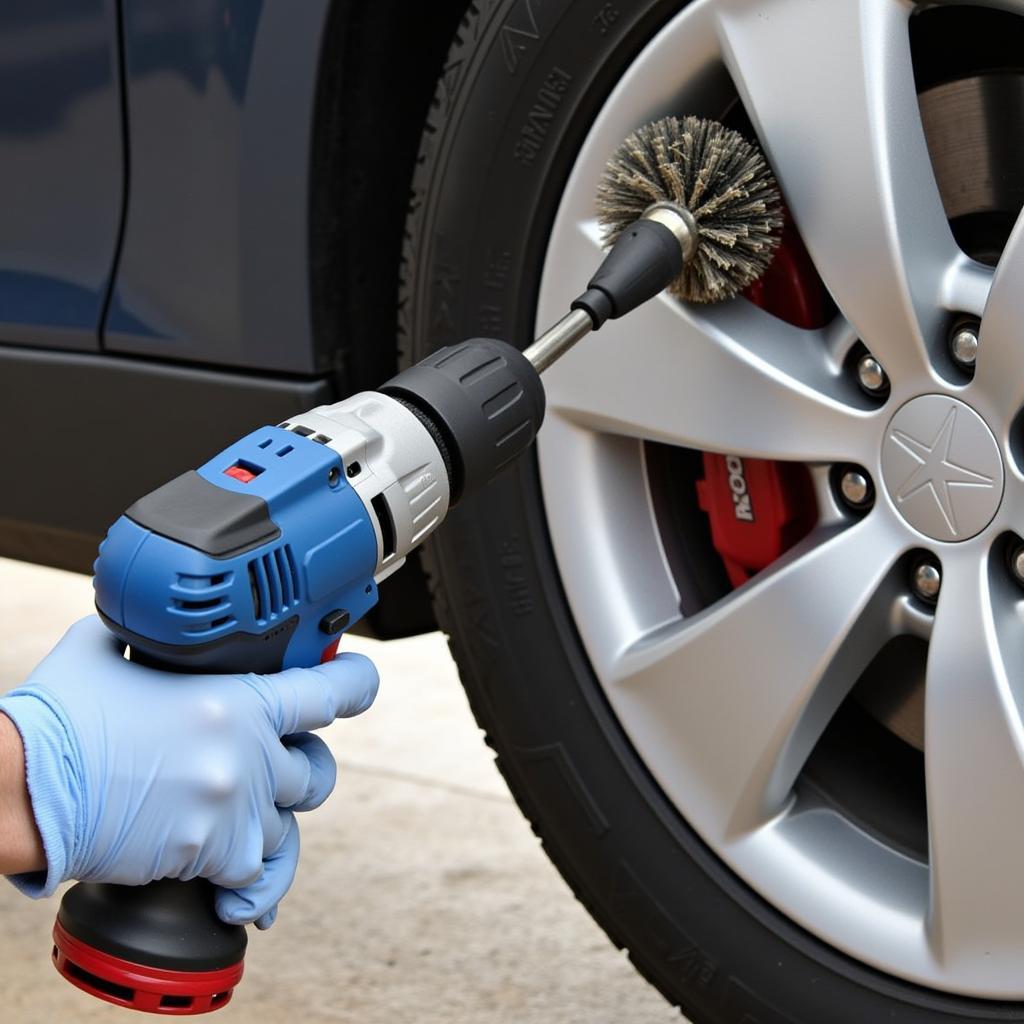A drill brush attachment can be a total game-changer for your car detailing routine. It’s a simple yet powerful tool that helps you achieve professional-level results right at home. Whether you’re tackling stubborn dirt on your floor mats, restoring the shine to your wheels, or cleaning those hard-to-reach areas around your dashboard, a drill brush attachment is your secret weapon for effortless cleaning.
Why Use a Drill Brush Attachment for Car Detailing?
Let’s face it: car detailing can be time-consuming and physically demanding. Hand scrubbing requires a lot of elbow grease, and even then, it can be challenging to reach tight spaces or remove ingrained dirt. That’s where a drill brush attachment comes in. It takes the hassle out of car detailing by providing:
- Increased Power: The rotating action of the drill combined with the cleaning power of the brush makes light work of even the toughest grime and dirt.
- Time Savings: Cleaning with a drill brush attachment is significantly faster than hand scrubbing, freeing up your time for other tasks.
- Versatility: Drill brush attachments come in a variety of shapes, sizes, and stiffness levels, making them suitable for cleaning different areas of your car’s interior and exterior.
- Improved Results: The combination of power and precision offered by a drill brush attachment allows you to achieve a deeper clean and restore your car’s showroom shine.
Choosing the Right Drill Brush Attachment for the Job
The effectiveness of your drill brush attachment hinges on choosing the right one for the task at hand. Here’s a quick guide:
Brush Size and Shape:
- Small Round Brushes: Ideal for cleaning tight spaces, intricate details, and delicate surfaces.
- Large Round Brushes: Perfect for cleaning larger surface areas like floor mats, carpets, and leather seats.
- Cone-Shaped Brushes: Designed for reaching tight corners, crevices, and around emblems.
- Flat Brushes: Suitable for cleaning flat surfaces like dashboards, door panels, and engine bays.
Brush Stiffness:
- Soft Bristles: Best for delicate surfaces like leather, vinyl, and polished metal.
- Medium Bristles: A good all-rounder for cleaning a variety of surfaces, including fabric upholstery, carpets, and plastics.
- Stiff Bristles: Reserved for heavy-duty cleaning tasks like removing stubborn dirt, grime, and mud from tires, wheels, and engine components.
Brush Material:
- Nylon Bristles: Durable and chemical-resistant, making them suitable for most car detailing tasks.
- Natural Bristles: Gentler than nylon, ideal for cleaning delicate surfaces or applying wax and polish.
- Brass Bristles: Extremely tough, best used for removing rust, corrosion, or stubborn dirt from metal parts.
How to Use a Drill Brush Attachment Safely and Effectively
While drill brush attachments are incredibly useful, it’s crucial to prioritize safety and effectiveness. Here are some essential tips:
- Start with a Clean Car: Before using a drill brush attachment, give your car a quick wash to remove loose dirt and debris. This prevents the brush from pushing dirt around and scratching surfaces.
- Choose the Right Speed: Always start with the lowest speed setting on your drill and gradually increase it as needed. Using too high a speed can cause damage to your car’s finish or the brush itself.
- Use the Right Cleaning Products: Always select cleaning products that are safe for the specific surface you’re cleaning. Avoid using harsh chemicals or abrasive cleaners, as these can damage your car’s paint or interior materials.
- Apply Light Pressure: Let the brush do the work and avoid applying excessive pressure. Too much pressure can lead to uneven cleaning or damage to the surface.
- Work in Small Sections: Divide larger areas into smaller sections and work your way across systematically. This ensures a consistent clean and prevents you from missing any spots.
- Rinse and Dry Thoroughly: After cleaning, rinse the area thoroughly with clean water to remove any cleaning solution residue. Dry the surface with a microfiber towel to prevent water spots.
Pro Tip: Wear safety glasses and gloves while using a drill brush attachment to protect yourself from flying debris and cleaning chemicals.
 Using a Drill Brush on a Car Wheel
Using a Drill Brush on a Car Wheel
Frequently Asked Questions about Drill Brush Attachments for Car Detailing
Q: Can I use a regular drill with a drill brush attachment?
A: Yes, most drill brush attachments are designed to fit standard drill chucks. However, it’s recommended to use a cordless drill with adjustable speed settings for greater control and maneuverability.
Q: How often should I clean my drill brush attachments?
A: Clean your drill brush attachments after each use to prevent dirt and grime buildup. You can simply rinse them under running water or wash them with soap and water if needed.
Q: Can I use a drill brush attachment on all parts of my car?
A: While drill brush attachments are versatile, it’s essential to avoid using them on delicate surfaces like your car’s paintwork. They are best suited for cleaning wheels, tires, engine bays, and interior surfaces like carpets, floor mats, and upholstery.
Conclusion
A drill brush attachment is an invaluable tool for any car detailing enthusiast. It streamlines the cleaning process, saves time and effort, and helps you achieve professional-looking results. By understanding the different types of drill brush attachments, using them safely and effectively, and following our expert tips, you can unlock the full potential of this versatile tool and keep your car looking its best.

Leave a Reply